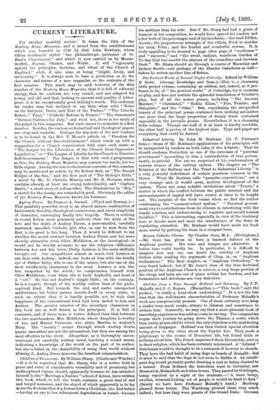CURRENT LITERATURE.
Yet another monthly review ! It bears the title of the Newbery House Magazine, and is issued from the establishment which was founded in 1740 by that John Newbery, whom Oliver Goldsmith styled "the philanthropic publisher of St. Paul's Churchyard," and which is now carried on by Messrs. Griffith, Farran, Okeden, and Welsh. It will "vigorously uphold the principles, doctrine, and ritual of the Church of England," while it also aims at being "bright, lively, and interesting." It is always rash to base a prediction as to the character and future of a new magazine on the contents of the first number. This much may be said, however, of the first number of the Newbery House Magazine, that it is full of editorial. energy, that its contents are very varied, and are adapted for young and old, and that, looking to amount and quality of letter- press, it is an exceptionally good shilling's worth. The ordinary lay reader may feel inclined to say that, what with "Notes on the Subjects, Dates, and Text of the Psalms," "The Lincoln Rubric," Trial," "Catholic Reform in France," " The Ornaments "Sermon Outlines for July," and what not, there is too much of the pulpit in this magazine. But such excess is excusable in a first number. Besides, the various ecclesiastical and theological papers are crisp and readable. Perhaps the key-note of the new venture
• is to be found in the Rev. T. Moore's article on "Freedom for
the Church without Disestablishment," which winds up with a suggestion for a Church organisation with some such name as "The League for the Liberation of the Church from Oppressive Legislation," or "The League of Liberty for the Church to Exercise Self-Government." The danger is that with such a programme as this, the Newbery House Magazine may contain too much, not too little vigour. Among the non-ecclesiastical contents of this number may be mentioned an article by Sir Robert Ball, on "The Recent Eclipse of the San," and the first part of "The Bishop's Bible," a novel by Mr. D. Christie Murray and Mr. H. Herman, which contains already at least one strong individuality, and "Captain Smith," a short story of self-sacrifice. The illustrations in "Boy," a sketch for the young, are remarkably good. Obviously the editor of the Newbery House Magazine knows his business.










































 Previous page
Previous page